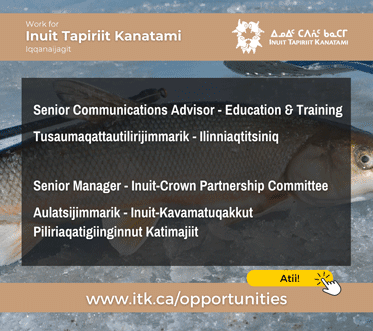Japan keen on buying Nunavut uranium
Uranium would be used for electricity only, Japanese Kiggavik mine project partner says

Tomio Hamai, vice-president of exploration and development with JCU, stands in front of the booth of Areva Resources Ltd. at Nunavut Mining Symposium’s April 10 trade show in Iqaluit. (PHOTO BY JANE GEORGE)
Japan will need uranium from Nunavut to help power its nuclear reactors.
That’s despite the Fukushima-Daiichi nuclear power plant meltdown in March 2011, which has dampened interest in nuclear power, said Tomio Hamai, vice-president of exploration and development with JCU, April 11 at the Nunavut Mining Symposium in Iqaluit.
With Areva Resources Canada, JCU owns 33.5 per cent of the Kiggavik project, located 80 kilometres west of Baker Lake in central Nunavut. The rest of the project is owned by Areva and Daewoo International Corp. of Korea.
After the Fukushima meltdown, a result of a devastating earthquake and tsunami, only four of 50 nuclear reactors in Japan are operating today, Hamai said.
But JCU wants to invest in uranium resources for future needs at the nuclear power plants in Japan, he said, and Kiggavik, if all goes according to plan, could start to provide some of that uranium in about 2020.
The company also holds an interest in 16 projects in Canada in joint ventures, including seven with Areva, and nearly all in Saskatchewan.
At Kiggavik, JCU has spent about $83 million on exploration, of the total $268 million spent there to date on exploration.
All the uranium from JCU’s share in Kiggavik — should the mine project move into production — will go to Japan and be used by local Japanese power companies to fuel their reactors, Hamai said.
Japan doesn’t have any of its own uranium mines, so partnering with Areva is one way of securing a uranium supply, he said.
And it’s exciting to be involved with a uranium project in the North, said Hamai, who lives in Tokyo.
As an investment, it’s also safe because “Canada is very stable politically,” he said.
So far, Hamai said JCU has received a lot of support to start uranium mining in Nunavut.
Hamai’s visit to attend the Nunavut Mining Symposium, April 8 to April 11, marked his first time in Iqaluit, although he has visited the Kiggavik project site at Baker Lake a few times.
Asked about Iqaluit, Hamai said he was surprised to find “it’s bigger than Baker Lake.”
He also found it “very encouraging for the mining industry in Nunavut” to see 500 people attend the Nunavut Mining Symposium.
“That’s one reason why I’m here — to show a presence,” he said.
“We’re a stable partner, we’re not a junior company that will tomorrow may not be around or have a financing problem,” said Suraj Ahuja, a geological consultant with JCU, who also attended the symposium.
“We are optimistic that these reactors [in Japan] will slowly restart,” he said.
The Canadian uranium, from a “very stable regime,” will be used only to produce electricity only, Ahuja said.
The Kiggavik partners also plan to help the local economy and use local supplies, create jobs, and work on keeping community support.
Nunavut will grow through mining activity, Ahuja said.
“You saw what one gold mine has done to Baker Lake,” he said, referring to the impact of Agnico-Eagle Mines Ltd.’s Meadowbank mine.
“We’re hoping that we will continue that tradition and that kind of contribution, Ahuja added.
Globally in 2012, mines produced 130 million pounds of uranium.
If Kiggavik goes into production, the mine should produce between eight and 10 million pounds.





(0) Comments